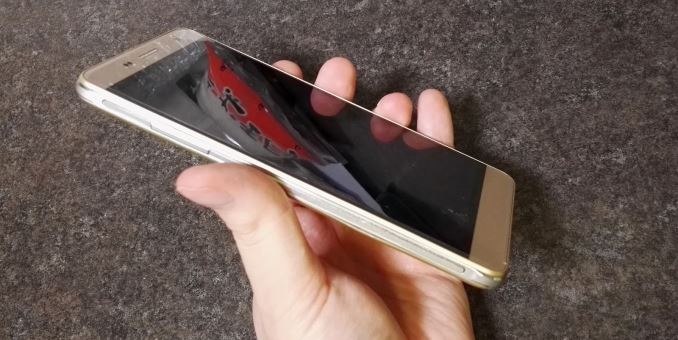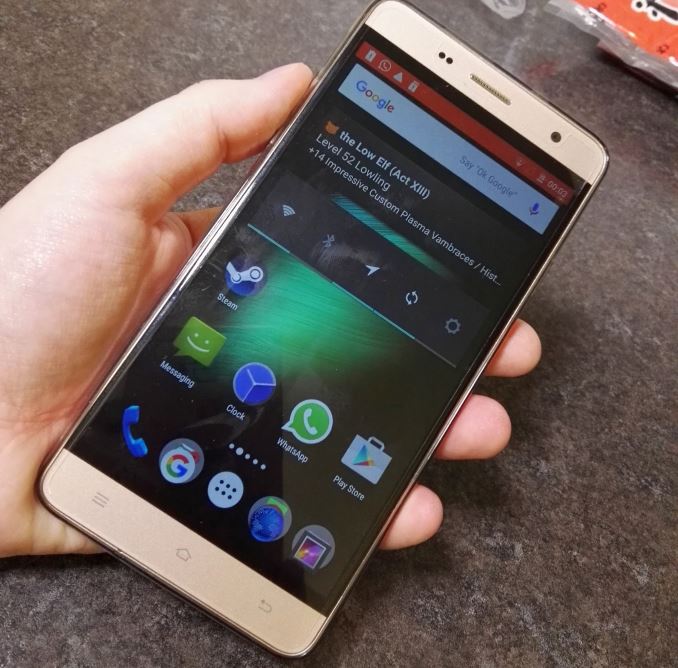The CUBOT H1 Smartphone Test: A Month with 3-4 Days of Battery per Charge
by Ian Cutress on December 23, 2015 9:01 AM EST- Posted in
- Smartphones
- Mobile
- Battery
- CUBOT
Final Words
I'll be brutally honest - while I keep a good tab on some elements of the smartphone market, more so on the business side, when it comes to deep dive analysis I leave it in the hands of Josh, Andrei and Brandon. That doesn't mean I don't need a device though, and despite their suggestions it seems I wanted a lot and wasn't prepared to spend the money. As a technical editor, my search for a smartphone caused a series of positive and negative feedback loops - some days I'd decide that DRAM was the most important, whereas others it would be the display resolution or the storage capacity. In the end it comes down to compromise and what is good and within range at the time I was looking. At one point I was adamant I wanted something more powerful than a Snapdragon 600 series, but I've ended up with a quad core MediaTek A53 device running at low frequency. There were some no-brainers – it had to be big enough and good enough to work on when I have short 20 minute public transport trips, and support dual SIM so I don’t have to keep losing my SIM card each time I travel.
The CUBOT H1 was the result of the search. It’s a smartphone that boasts 5200 mAh of battery, which is 3.4x the size of the battery in the iPhone 5c or 2x the battery in the Galaxy S6. When combined with the 1280x720 screen and the 1 GHz quad-core SoC, it gave 4 days of standard use battery which translated to 15 hours and 26 minutes on the PCMark battery test that runs from 100% to 20%, beating the Zenfone 2 by over nine hours. That is pretty much pre-2000 smartphone territory, more akin to what we used to have when playing games like Snake.
My smartphone use case has adapted over time – I want it to do work on. That means writing, switching between apps, being somewhat responsive, and always being available. The SoC means it doesn’t break any sort of record for performance, but ultimately so much of my use doesn’t require performance but rather latency in app switching and updates. Having enough memory to keep apps available means a lot, so moving up from 1GB to 2GB was a big enough change to notice, as well as the bump up to Android 5.1. The 16GB storage model is pretty basic, and the microSD compatibility is only at 32GB, rather than something bigger, and I know it will fill over time with the consistent photographing of my cats. But that is a risk that I’m going to have to take, or synchronize with Dropbox.
Without the silicone case that comes free with the phone, I will grant that despite the patterned edge, it does feel like the plastic the rear is made from, and arguably it slips out of the hand too easily. With the silicone case, it just feels like a smartphone with a case, which a lot of people use anyway. The raised power and volume buttons helps discern their location, and the fixed buttons is something I like to have on my device, even if it means giving up screen real estate.
It is clear that the cameras are not for taking glamour shots. But at a trade show, as long as you are in the front row, and have a second or two between shots, taking pictures of slides to work on later is good enough. To get a good shot taking advantage of the EIS though, you really need to use the burst mode which supports 40 shots at 13 MP each. The video is also an afterthought. That comes down to the price and what needs to be cut to meet that price. I purchased the device, brand new from Amazon, for £125 which translates to $160 pre-tax. Almost everyone I showed the phone to, probably due to the battery life argument, thought it was more expensive. The only people who guessed under (and only by $10) were a pair of senior ARM employees. But truth be told, I could buy four of these a year and it would still be cheaper than an S6. Of course, there are obvious caveats with that comparison.
I would say that this is going to be my phone for the next two years. But since I purchased it in October, two extra high end smartphones that others at AnandTech have tested have both landed on my desk for similar experiential testing. It almost seems sad to shelve the Cubot H1 immediately unless I adapt to carry two phones at once, with the H1 as that long-battery backup.
| CUBOT H1 | ||
| SoC | Mediatek MT6735P 4x ARM Cortex-A53 at 977 MHz ARM Mali-T720 MP2 at 400 MHz |
|
| RAM | 2GB LPDDR3 at 533 MHz | |
| Storage | 16GB NAND | |
| Display | 5.5” 720p IPS | |
| Modem | 2G / 3G / 4G LTE UE Category 4 DC-HSPA+, TD-SCDMA, CDMA2000 1x/EVDO Rev. A, EDGE |
|
| Networks |
TDD LTE | None |
| FDD LTE | B1 / B3 / B7 / B20 | |
| UMTS | 900 / 1900 / 2100 | |
| GSM | 850 / 900 / 1800 / 1900 | |
| Dimensions | 154.5 (h) x 76.6 (w) x 9.2 (d) mm, 201 grams* Weight Measured by AnandTech, conflicting numbers online |
|
| Cameras | Rear | 12.8MP ( 4128 x 3096 ) |
| Front | 8MP ( 3264 x 2448 ) | |
| Battery | 5200 mAh (19.76 Whr) | |
| OS | Android 5.1 | |
| Connectivity | 802.11a/b/g/n 2.4GHz BT 4.0, GPS, A-GPS, Micro-USB |
|
| SIM Size | Micro-SIM (FDD-LTE, WCDMA, GSM) Nano-SIM (GSM Only) Also Separate MicroSD slot, up to 32GB |
|
| MSRP (UK) | 16GB | $160
£125 as purchased |
So the final question becomes ‘how is it pronounced?’ Do we say cue-bot? Or perhaps cub-bot, or cue-bow? After writing this review, and looking at their online ‘CUBOT enterprise propaganda film’ on YouTube, it turns out to be coo-bot.












116 Comments
View All Comments
shabby - Wednesday, December 23, 2015 - link
Perhaps we should stop calling these phones since only one sentence is used to describe its calling ability.Mushkins - Wednesday, December 23, 2015 - link
To be fair, what else do you need in a review of a voice call? Either it sounds like you're talking through a tube full of muddy squirrels or it sounds like a cell phone quality voice call (aka tolerable but not great). Getting into technical metrics of sound quality for a voice call is overkill for a consumer-focused review of a smartphone.aggiechase37 - Wednesday, December 23, 2015 - link
See I have to disagree here. If I want drive by, non specific reviews I would go to something like PCmag, where everything is, "seemed fine to me." Drivel. I come to Anandtech because I want in depth reviews. I do wish the call quality portion of the review was more in depth. I use my phone for a lot of business as well, and having the other person perceive my call quality as being crapola is a very important consideration for me. Dear Anandtech, please spend more time on call quality in your reviews. Please!?!?raja_jagadeesan - Wednesday, December 23, 2015 - link
I might agree with aggiechase. I actually find anandtech's cell phone reviews pretty outstanding. But adding more technical metrics or objective measures of call quality would really add value, I think. Partly because it is so hard to find elsewhere. My wife complains about her call quality and I sometimes wonder how to differentiate whether we need a new service or a new phone or if it is the Wi-Fi calling that is at issue, etc. More technical analysis of actual call quality and calling experience would be very useful.Ian Cutress - Wednesday, December 23, 2015 - link
Hi aggiechase37,I'm not the typical smartphone reviewer, as you might imagine from this review. It was originally going to be a hands on piece, like my previous One max piece (link below), but 750 words quickly became 3000 as I explored more aspects of the phone. It wasn't intended to be a full blown expose such as what we normally do, especially given the scale of the device, partly because I don't have the tools but also it's more an experiential test than anything else.
-Ian
My previous One max road test: http://www.anandtech.com/show/7551/a-month-with-th...
jjj - Wednesday, December 23, 2015 - link
The most important metric would be signal strength and nobody can be bothered to test that since blaming the carrier for dropped calls instead of the phone maker is easier.. The most reliable public info is this (in danish) http://www.dr.dk/nyheder/penge/kontant/saa-daarlig... or in English try this http://www.gsmarena.com/apple_iphone_6s_reception_...saratoga4 - Wednesday, December 23, 2015 - link
That would be an extraordinarily difficult test to perform accurately and in a way that was fair to devices with different types of radios. Even simple antenna testing (disconnected from a radio) is complex, testing an antenna, a radio, and firmware is probably beyond the means review sites.jjj - Wednesday, December 23, 2015 - link
Yes and no, you can try to do your best and achieve reasonable results with limited resources.A little data is a lot better than no data at all.
jjj - Wednesday, December 23, 2015 - link
Nowadays it helps that you can buy very cheap Chinese tools from places like Aliexpress. Sure a 100$ tool is not as good as a 5k$ tool but can be decent in many cases.Notmyusualid - Sunday, December 27, 2015 - link
It would still be very useful information!Keep it simple, test each phone in a number of fixed locations, at a specific time of day for each handset (to keep the network load 'fixed'), and run your call / data tests.
Repeat all the above on a 2.5hr+ train journey (similar to how the Japanese test theirs) to monitor call hand-off etc too...
A pattern will nevertheless emerge of who makes the most sensitive receivers, and as you allude to - how the total package ends up working.